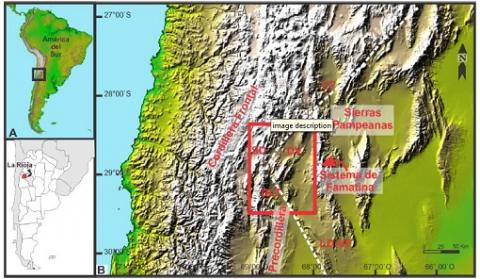Patricia L. Ciccioli
2 017
Anales Acad. Nac. de Cs. Ex., Fís. y Nat., tomo 69 (2017): 68-82.
La propuesta de este trabajo es mostrar la importancia de la integración de distintos métodos para analizar la procedencia de una unidad estratigráfica. Se toma como caso de estudio a la Formación Toro Negro (Mio-Pleistoceno temprano) en la Quebrada de la Troya, Sierra de Los Colorados, provincia de La Rioja. Esta unidad representa el relleno de la cuenca de antepaís fracturado de Vinchina con múltiples áreas de aporte. Se presentan los resultados obtenidos mediante el empleo de modas detríticas en areniscas y edades U-Pb en circones detríticos. Tales resultados permiten interpretar que la Sierra de Toro Negro fue una de las principales áreas de aporte para la Formación Toro Negro durante la depositación de las Secuencias Depositacionales (SD) I y II (~6.8-5 Ma) con menor participación de la Precordillera y Cordillera Frontal. A su vez un progresivo incremento en el aporte de la Precordillera es interpretado desde la SDII y SDIII (~6,1-2,3 Ma) evidenciando probablemente el levantamiento de uno de los corrimientos más orientales de la Precordillera.
Provenance studies of the Toro Negro Formation based on detrital modes and U-Pb detrital zircon ages: implications on the evolution of the Andean broken foreland (La Rioja).
Provenance studies of the Toro Negro Formation based on detrital modes and U-Pb detrital zircon ages: implications on the evolution of the Andean broken foreland (La Rioja). The goal of this paper is to show the importance of the integration of different study methods to analyze the provenance of a stratigraphic unit. The Toro Negro Formation (Mio-early Pleistocene) is taken as a case study in the Quebrada de La Troya, Sierra de Los Colorados, province of La Rioja. This unit represents the filling of the Vinchina broken foreland basin with multiple source areas. The results obtained by the use of detrital modes in sandstones and U-Pb ages in detrital zircons are presented. These results allow interpreting that the Sierra de Toro Negro was one of the main source areas for the Depositional Sequences (DS) I and II of the Toro Negro Formation with less participation of the Precordillera and Cordillera Frontal (~6.8-5 Ma). At the same time, a progressive increase in the contribution of the Precordillera is interpreted from the DSII and DSIII (~6.1-2.3 Ma) evidencing probably the uplifting of one of the easternmost thrusts of Precordillera.
Provenance studies of the Toro Negro Formation based on detrital modes and U-Pb detrital zircon ages: implications on the evolution of the Andean broken foreland (La Rioja). The goal of this paper is to show the importance of the integration of different study methods to analyze the provenance of a stratigraphic unit. The Toro Negro Formation (Mio-early Pleistocene) is taken as a case study in the Quebrada de La Troya, Sierra de Los Colorados, province of La Rioja. This unit represents the filling of the Vinchina broken foreland basin with multiple source areas. The results obtained by the use of detrital modes in sandstones and U-Pb ages in detrital zircons are presented. These results allow interpreting that the Sierra de Toro Negro was one of the main source areas for the Depositional Sequences (DS) I and II of the Toro Negro Formation with less participation of the Precordillera and Cordillera Frontal (~6.8-5 Ma). At the same time, a progressive increase in the contribution of the Precordillera is interpreted from the DSII and DSIII (~6.1-2.3 Ma) evidencing probably the uplifting of one of the easternmost thrusts of Precordillera.

